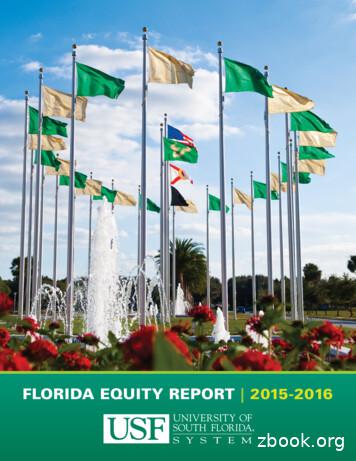Separation Sciences - University Of Florida
Separation Sciences1. Introduction: Fundamentals of Distribution Equilibrium2. Gas Chromatography (Chapter 2 & 3)3. Liquid Chromatography (Chapter 4 & 5)4. Other Analytical Separations (Chapter 6-8)a. Planar chromatographyb. Supercritical fluid chromatographyc. Electrophoresisd. Centrifugatione. Field Flow Fractionation
Centrifugation1. Introduction. Centrifugation is a technique in whichsolutes are separated by their different rate of travel (orsedimentation) in a centrifugal field.2. Centrifugation is widely used inbiological separation.The solutes are usually cells,Sub-cellular organelles,viruses, large moleculessuch as proteinsand nucleic acids.Theodor Svedberg
2. Theory of centrifugationSedimentation rate of solutes is determined by their size, shape, anddensity, and the density and viscosity of media. The ability of ansolute to centrifugal (or gravitational) field can be described bysedimentation coefficient (S v/C): v linear velocity of a solute, C:centrifugal acceleration.For a spherical solute:S 2/9 r2(d-do)/ Centrifugal forceS is the sedimentation coefficient and is usually expressedin Svedbergs (S) or 10-13 sec.r: radius of the solute, d: density of the solute, d0: density ofmedia, and :viscosity of the media.S2r2 2 d2 –d0()* S1d1 –d0r1Iso-densitySedimentation coefficients of two solutesin a centrifugal field.
3. Why do we need ultracentrifuge for separations?SampleSed. coeff (S)whole cells106cell nuclei105Mitochondria104Ribosomes30, 50 Ssolubleproteins1 - 5 (globular)5 - 20 (elongated)S v/CC v/SFor v 0.01 mm/s,C?
4. Biological Applications
Field Flow Fractionation1. Introductiona. Field flow fractionation (FFF) is a technique in which solutes areseparated by their different rate of flow (or travel) through a channelto which a perpendicular field is applied.b. This technique was first proposed by J. Calvin Giddings in 1966.It is current an area of active research and development.
c. One of the major advantages of FFF is that its various techniquescan be used to separate molecules over a 1015-fold range of molecularweights. It is very useful for separation of colloids, proteins,polymers, and nanoparticles.d. Most separation in FFF can be easily described in terms offundamental physical parameters (e.g. diffusion coefficients, electrophoretic mobility, or sedimentation coefficient). This makes it easy topredict and optimize FFF separations.
2. TheoryThe basis of FFF is the presence of a laminar flow profile in aribbon-shaped flow channel.
3. Types of FFF:a.b.c.d.Electrical FFFSedimentation FFFThermal FFFFlow FFFa. Electrical FFFElectrophoretic mobility
b. Sedimentation FFFIt is used to separation of solutes withMolecular weights ranging from 106 to 1013 Dalton.(polymer particles, viruses, and entire sequencesof Single vs. double stranded DNA.Sedimentation coefficient
c. Thermal FFFi. The external field used in this technique is a temperature gradientacross the flow channel. This is produced by heating or cooling theupper and lower walls of the flow channel to different degrees.ii. In the presence of this temperature gradient, solutes will undergo“thermal diffusion” and migrate within the gradient to different extents.This technique is effective for the separation of synthetic plymer withMW. 103 107 D in organic solution.d. Flow FFFInstead of an external field, a slowtransverse flow of the carrier liquid is usedin this technique. Flow FFF has beenapplied to a variety of solutes includingproteins, polymers and colloidal particles.
Separation Sciences1. Introduction: Fundamentals of Distribution Equilibrium2. Gas Chromatography (Chapter 2 & 3)3. Liquid Chromatography (Chapter 4 & 5)4. Other Analytical Separations (Chapter 6-8)a. Planar chromatographyb. Supercritical fluid chromatographyc. Electrophoresisd. Centrifugatione. Field Flow Fractionation
2. Gas Chromatography (Chapter 2 & 3) 3. Liquid Chromatography (Chapter 4 & 5) 4. Other Analytical Separations (Chapter 6-8) a. Planar chromatography b. Supercritical fluid chromatography c. Electrophoresis d. Centrifugation e. Field Flow Fractionation Separation Sciences
FLORIDA WETLAND PLANTS, AN mENTIFICATION MANUAL can be purchased from the University of Florida, Food and Agricultural Sciences. 1-800-226-1764, P.O. Box 110011, University of Florida, Gainesville, Florida 32611-0011. Introduction For use the the manual: FLORIDA WETLAND PLANTS, AN mENTIFICATION MANUAL
separation tank components are damaged, notify the freight carrier immediately. 2. After inspection, carefully remove the separation tank and air bleeder valve from the carton. 3. Assemble air bleeder valve on top of separation tank. 4. Mount separation tanks on a per
The Annual Florida Equity Report is required under Florida statutes as follows: The Florida Educational Equity Act (Section 1000.05 F.S.) and the Florida Board of Governors Regulation 2.003 Equity and Access. The Uni-versity of South Florida System (USF System), which is comprised of three institutions USF Tampa, USF St.
Section 53: Social and Political Sciences Section 54: Economic Sciences Class VI: Applied Biological, Agricultural, and Environmental Sciences Section 61: Animal, Nutritional, and Applied Microbial Sciences Section 62: Plant, Soil, and Microbial Sciences Section 63: Environmental Sciences and Ecology Section 64: Human Environmental Sciences
Table 7. Doctorate-granting institutions, by state or location and major science and engineering fields of study: 2016 State or location and institution Science Engineering Life sciences and earth sciences sciences Psychology and social sciences Sociology Other social sciences
2016-Present: Full Professor, College of Marine Sciences, University of South Florida, St. Petersburg, Florida . 2000-2015: Associate Professor, College of Marine Sciences, University of South Florida, St. Petersburg, Florida. (Tenure awarded June 2004). 1997-2000: Joint F
distillation, absorption, crystallization, filtration, centrifugation, drying and membrane processes. Separation processes are primarily based on physical means and some on physico-chemical means. This chapter is to introduce the general concepts of separation technology and some common separation processes in chemical and bioprocess technology. 2.
needs of air separation plants. Background A typical air separation plant divides atmospheric air into the three pure gaseous components of nitrogen (N 2), oxygen (O 2) and argon (Ar). Some plants provide further separation to include other gases such as neon, krypton and xenon. Other gas co























